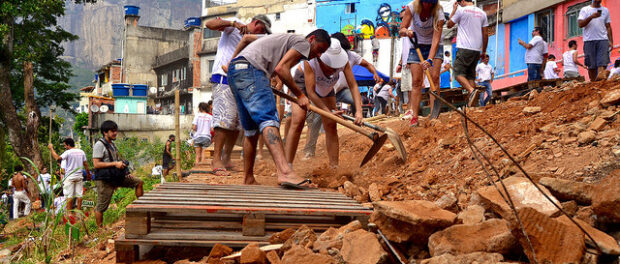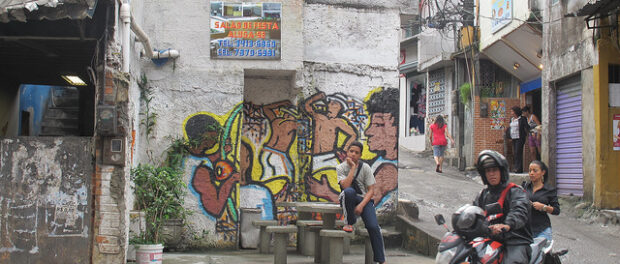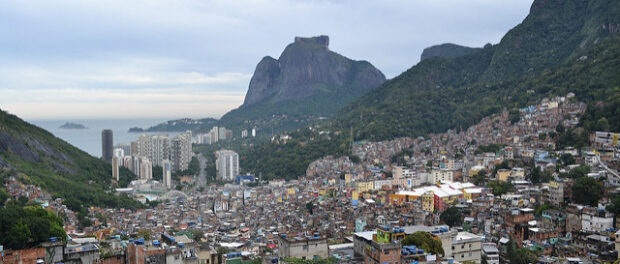
This is the fifth in a five-part series titled Housing Policy Lessons from Rio’s Favelas. We hope this series will inform debates on housing and favela upgrading and that Rio’s new mayor, Marcelo Crivella, will design policies that address the challenges favelas face while recognizing and strengthening their attributes, by actively engaging with residents in policy design and implementation.
Lesson 10: Policy solutions should be sourced in Rio’s favelas
Through understanding the needs and experiences of favela communities, it is possible to come up with solutions for housing policy based on these communities’ lived experiences, rather than imposing top-down solutions, which inevitably fail due to their lack of grounding in the actual lives and needs of residents. This final article in the series describes policy ideas that emerged from speaking to residents in over 15 communities and academic institutions across Rio. They represent a fraction of the multitude of ideas that can emerge from listening to the voices of those who experience policy impacts on a daily basis.
1. Provide technical help, building materials and loans to favela communities as they build their homes
One common complaint among residents of hillside favelas was the challenge of getting building materials up steep hills. Others complained of their initial lack of technical expertise that led them to rebuild their homes more than once, as they learned through doing. In all favelas, one hears stories of how many years, often generations, it took to build, and re-build, a home to get it to where it is now. Residents who have been successful speak of this experience with tremendous pride, while those who struggle over decades and are unable to dramatically improve their living conditions may suffer endlessly.
While part of supporting communities should be implementing parameters that prevent unsafe building and building in precarious “areas of risk,” this risk is usually overstated in Rio. Rather, in consolidated favelas, where communities have become established and valuable assets built up, the policy focus should be on providing technical support, building materials and loans to allow residents to complete their homes and bring them up to standard. In the 1960s, a municipal program provided engineering assistance and materials to residents who built their own homes. More recently, the underfunded and marginalized POUSO, or Urbanistic and Social Orientation Posts, were a popular policy that provided much-needed technical support.
Residents of informal communities also have a difficult time accessing credit to build or improve their homes. A policy of providing small-scale low-interest loans to residents who wish to invest in homes and a streamlined channel to buy inexpensive building materials, or subsidized materials, should be considered. This could be done by creating contracts with local material stores, for example.
“I think there should be a government program to assist with engineering and construction because every house that is going to be built needs the basics. You have to have a professional helping to do this.” – Cabritos, South Zone
“Sometimes the city comes here with technical help and the resident has the more specialized eye. You have to have this partnering of institutions. The team that did Rio+Social [before it was dismantled] was sensational. They did really good work that documented all the needs here. It worked really well because the engineer was part of many institutions. They had meetings with the people to assess the needs.” – City of God, West Zone
2. Learn from effective high-participation programs such as Minha Casa Minha Vida-Entidades
Rio’s new housing policies must specify and guarantee mechanisms for extensive participation. Inspiration should be taken from the self-built public housing projects associated with the Minha Casa Minha Vida-Entidades program (MCMV-En), one of few examples to date in Rio de Janeiro of full citizen control over the planning process.
“Rio’s city government is very closed off to participation. It, at minimum, has to install and update the neighborhood councils across the city. No urban intervention can be implemented without effective participation from the communities. This is consecrated in the Statute of the City. I am not talking about anything that is not in the law.” – Rio de Janeiro Federal University’s Institute of Urban and Regional Planning Research (UFRJ/IPPUR)
3. Design favela zoning laws that protect affordability
Favelas are Rio’s affordable housing stock and, without sufficient non-favela affordable housing to meet the city’s affordable housing needs, must be protected as such through zoning, or else, as speculation is introduced, new, precarious favelas, will form elsewhere. An example would be zoning for small lots and the exclusion of large-scale commercial activities, or properly implementing Brazil’s Areas of Special Social Interest legislation.
“When legislation prohibits large lots and prohibits commercial or residential use at a high level, what is it doing? It is protecting the residents. It then isolates the area a bit from the market. This can be a barrier that inhibits gentrification.” – UFRJ/IPPUR
“By law, these are Areas of Special Social Interest. They should have an upgrading plan that is defined in the Master Plan of Rio de Janeiro–an occupation use law discussed by the community. None of the favelas have this, not one of them.” – UFRJ IPURR
4. Implement comprehensive city-wide favela upgrading
The city must prioritize upgrading as opposed to removals. Globally now, common sense urban policy, vis-à-vis the New Urban Agenda, prioritizes upgrading. Brazilian law, the nation’s urban planning professionals, and Rio’s politicians themselves, who in the 1990s instituted the world’s first large-scale favela upgrading program, have concluded this for decades. Yet this message has been left behind by policy-makers in Rio since 2008 when Favela-Bairro was completed and given its successor, the much-heralded Morar Carioca program, was abandoned and effectively dismantled by Rio Olympic Mayor Eduardo Paes (2008-2016). This means that for nearly ten years Rio has experienced no policy of comprehensive favela upgrading. It is time to return to such a policy, in the form of Morar Carioca or an improved version.
“[The ideal] would be to have an upgrading policy for everything, to reinforce the houses that already exist. That way the structure of the favela would be upgraded.” – Rocinha, South Zone
“You have to look at both sides. You have to create new homes to address the deficit. And on the other hand, you have to improve the housing that already exists to overcome the problem of inadequate housing.” – UFRJ/IPPUR
5. Adapt the implementation of federal housing program Minha Casa Minha Vida to include better design, prioritize central areas, and not use the program for victims of forced eviction
Since the Minha Casa Minha Vida (MCMV) federal housing program is decentralized, the city of Rio has leeway to adapt the policy in ways that fit the needs of the city. It must drastically readapt the to-date poorly implemented program to better integrate public housing units into the city’s urban fabric and take inspiration from the positive qualities found in Rio’s favelas. On a technical level, this could involve providing housing that can be easily adapted by residents to suit their needs, ensure public spaces and the ability to hold events and organize collectively to build community, locate housing with better access to hospitals, employment and schools. Public housing units are often too small, at 36m2. For an average sized family, the appropriate size for a public housing unit should be around 100m2 to fit a family of 4-5.
“The program should be designed so that it favors not just large scale housing construction, but quality housing. That is to say, housing that is adequate for the needs of the diverse population, not large, monotonous or repetitive projects.” – UFRJ/IPPUR
6. Ensure that important services like health, education, transport, leisure and sanitation are mandated to accompany any housing policy as well as robust participation measures
A primary problem many favela residents described was not about housing quality, but rather the rest of the built environment they depend on. Since most of a typical resident’s salary goes into improving one’s home environment, it is often the public infrastructure in and around favelas that most needs investment. Whether in public housing planning or favela upgrading, policies must emphasize the integration of all urban services into program design. Sewerage, education, and health infrastructure are consistently those services deemed most inadequate and consequently most in-demand by favela residents at public meetings.
“First, I think you have to put more services. It doesn’t work to have the intention of putting in housing without putting in services. Today, for example, we have a health post in City of God that does not attend to the entire favela. We need public policies that are more collective and that listen to the voice of the population.” – City of God, West Zone
7. Offer collective titling as an option for communities that want added protection and have strong community institutions
The Community Land Trust (CLT) model could be a great option to explore for those favelas where residents are more interested in guaranteeing their collective assets and with land security, than with individual residents’ ability to speculate.
“CLTs can be very good as long as they are negotiated internally. They cannot be imposed from the outside in because this would not work. They have to be negotiated between residents who have to have information about the advantages and disadvantages of each type of title. CLTs can protect the resident more and can make internal organizations stronger.” – UFRJ/IPPUR
Full Series: Housing Policy Lessons from Rio’s Favelas
Part 1: Construction and Community
Part 2: Collective Action and Diverse Needs
Part 3: Distrust, Gentrification and Titling
Part 4: Public Housing
Part 5: Proposing Solutions



